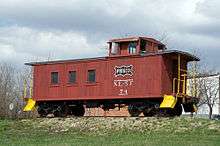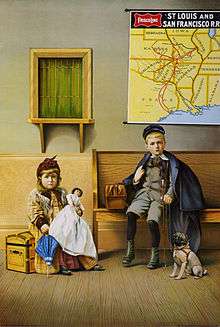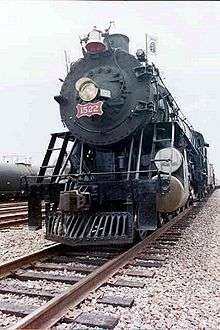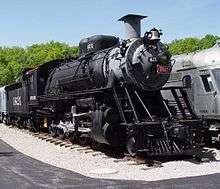St. Louis–San Francisco Railway
The St. Louis–San Francisco Railway (reporting mark SLSF), also known as the "Frisco", was a railroad that operated in the Midwest and South Central U.S. from 1876 to April 17, 1980. At the end of 1970, it operated 4,547 miles (7,318 km) of road on 6,574 miles (10,580 km) of track, not including subsidiaries Quanah, Acme and Pacific Railway or the Alabama, Tennessee and Northern Railroad; that year, it reported 12,795 million ton-miles of revenue freight and no passengers. It was purchased and absorbed into the Burlington Northern Railroad in 1980.[2] Despite its name, it never came close to San Francisco.
 | |
.svg.png) Frisco system as of 1918; the Fort Worth and Rio Grande in central Texas was sold to the Santa Fe Railway in 1937 | |
| Overview | |
|---|---|
| Headquarters | Springfield, Missouri[1] |
| Reporting mark | SLSF |
| Locale | Alabama, Arkansas, Florida, Kansas, Mississippi, Missouri, Oklahoma, Tennessee, Texas |
| Dates of operation | 1876–1980 |
| Successor | Burlington Northern |
| Technical | |
| Track gauge | 4 ft 8 1⁄2 in (1,435 mm) standard gauge |
History

.jpg)
The St. Louis–San Francisco Railway was incorporated in Missouri on September 7, 1876. It was formed from the Missouri Division and Central Division of the Atlantic and Pacific Railroad. This land grant line was one of two railroads (the other being the M-K-T) authorized to build across Indian Territory. The Atchison, Topeka and Santa Fe Railroad, interested in the A&P right of way across the Mojave Desert to California, took the road over until the larger road went bankrupt in 1893; the receivers retained the western right of way but divested the ATSF of the St. Louis–San Francisco mileage on the Great Plains. After bankruptcy, the Frisco emerged as the St. Louis and San Francisco Railroad, incorporated on June 29, 1896,[3][4] which also went bankrupt. On August 24, 1916, the company was reorganized as the St. Louis–San Francisco Railway, though the line never went west of Texas, terminating more than 1,000 miles (1,600 km) from San Francisco.
The St. Louis–San Francisco Railway had two main lines: St. Louis–Tulsa–Oklahoma City-Floydada, Texas and Kansas City–Memphis–Birmingham. The junction of the two lines was in Springfield, Missouri, home to the company's main shop facility and headquarters. Other lines included:
- Springfield–Kansas City (via Clinton, Missouri)
- Monett, Missouri (Pierce City)–Wichita, Kansas
- Monett, Missouri–Hugo, Oklahoma–Paris, Texas
- St. Louis–River Junction, Arkansas (Memphis, Tennessee)
- Tulsa, Oklahoma–Dallas, Texas
- Tulsa, Oklahoma–Avard, Oklahoma
- Lakeside, Oklahoma–Hugo, Oklahoma–Hope, Arkansas
- Amory, Mississippi-Pensacola, Florida
From March 1917 through January 1959, the Frisco, in a joint venture with the Missouri–Kansas–Texas Railroad, operated the Texas Special. This luxurious train, a streamliner from 1947, ran from St. Louis to Dallas, Texas, Fort Worth, Texas, and San Antonio, Texas.
The Frisco merged into the Burlington Northern Railroad on November 21, 1980.[2]
The city of Frisco, Texas, was named after the railroad and uses the former railroad's logo as its own logo. The logo is modeled after a stretched-out raccoon skin[5][6] (giving rise to Frisco High School's mascot, the Fighting Raccoons).
Passenger trains
.jpg)
While the Texas Special may be the most famous passenger train the Frisco ever operated, it also had an entire fleet of named trains. These included:
- Black Gold (Tulsa–Dallas/Fort Worth overnight)
- Firefly (Kansas City–Tulsa, originally on to Oklahoma City)
- General Wood (Originally between St. Louis and Springfield, Missouri from May 1941; truncated in June 1942 to service between St. Louis and Newburg, Missouri; and, discontinued entirely in the fall of 1946.)[7]
- Kansas City–Florida Special (Kansas City–Jacksonville)
- Memphian (St. Louis–Memphis)
- Meteor (St. Louis–Tulsa-Oklahoma City by night with connecting train Monett-Fort Smith-Paris, TX)
- Oil Fields Special (Tulsa–Dallas/Ft. Worth by day)
- Oklahoman (Once connected Kansas City–Tulsa but was later rerouted between St. Louis–Oklahoma City)
- Southland (Kansas City–Birmingham) (truncated successor to the Kansas City–Florida Special)
- Sunnyland (Kansas City/St. Louis–Atlanta/Pensacola/New Orleans)
- Texas Flash (Tulsa-Sherman-Dallas by day)
- Texas Special (St. Louis-San Antonio)
- Will Rogers (St. Louis–Oklahoma City/Wichita by day)
- "Chadwick Flyer" (Branch line from Springfield to Chadwick, Missouri)
Former Frisco lines today

The core of the former Frisco system continues to be operated by BNSF Railway as high-density mainlines. Other secondary and branchlines have been sold to shortline operators or have been abandoned altogether.
- Kansas City – Springfield – Memphis – Birmingham: Operated by BNSF
- St. Louis – Springfield – Tulsa – Dallas: Operated by BNSF
- Fort Scott, Kansas to Afton, Oklahoma: Operated by BNSF
- St. Louis to Memphis, Tennessee: Operated by BNSF
- Tulsa, Oklahoma to Avard, Oklahoma: Operated by BNSF
- Fredonia, Kansas to Cherryvale, Kansas to Columbus, Kansas: Operated by South Kansas and Oklahoma Railroad
- Cherokee, Kansas to Pittsburg, Kansas: Operated by South Kansas and Oklahoma Railroad
- Fredonia, Kansas to Ellsworth, Kansas: Abandoned
- Cherokee, Kansas to Cherryvale, Kansas: Abandoned
- Monett, Missouri to Fort Smith, Arkansas: Operated by Arkansas and Missouri Railroad
- Lakeside, Oklahoma to Hope, Arkansas: Operated by Kiamichi Railroad (Genesee & Wyoming Inc.)
- Tulsa, Oklahoma (Sapulpa) to Oklahoma City, Oklahoma: Operated by Stillwater Central Railroad
- Oklahoma City to Snyder, Oklahoma: Operated by Stillwater Central Railroad
- Snyder, Oklahoma (Long Siding) to Quanah, Texas: Operated by BNSF
- Enid, Oklahoma to Frederick, Oklahoma: Operated by Grainbelt/Farmrail
- Amory, Mississippi to Pensacola, Florida: Operated by Alabama and Gulf Coast Railway (RailAmerica)
- Springfield to Kansas City (via Clinton)(two routes): Abandoned
- Monett (Pierce City) to Carthage, Missouri: Out of service
- Carthage, Missouri to Wichita, Kansas: Mostly abandoned
- Chaffee, Missouri to Poplar Bluff, Missouri to Hoxie, Arkansas (Hoxie Sub): Abandoned
Surviving equipment
Steam locomotives
- Frisco 19, a 2-8-0 Consolidation-type built in 1910 and on static display in Frisco, Texas located adjacent to the Frisco Depot replica and the BNSF tracks that run through the city.[8] (Note: This locomotive is lettered Frisco, but it did not actually operate on the SLSF. It is the former Lake Superior and Ishpeming Railroad 19. It was purchased by the City of Frisco, Texas, as a static display, and is representative of a typical Frisco locomotive. Frisco operated a number of Consolidations as Frisco-series 1306 engines.[9])
- Frisco 1351, built in 1912 as a 2-8-0 Consolidation (Frisco 1313), and converted by Frisco to a 2-8-2 Mikado in November 1943.[10] Now on static display in Collierville, Tennessee.[11]
- Frisco 1352, built by ALCO in 1912 as a 2-8-0 Consolidation (Frisco 1321), and converted by Frisco in the WWII timeframe to a 2-8-2 Mikado. Disassembled in Taylorville, Illinois; awaiting restoration to operating condition.[12]
- Frisco 1355, built by ALCO in 1912 as a 2-8-0 Consolidation (Frisco 1318), and converted to a 2-8-2 Mikado between 1943 and 1946 in Frisco’s main shops in Springfield.[13] Now displayed on Garden Street, Pensacola, Florida, near the site of the SLSF passenger depot demolished in 1967.[14]
- Frisco 1501, one of thirty 4-8-2 Mountain type locomotives purchased from Baldwin for freight and passenger service; this was an oil-burning model delivered in 1923.[15] On static display in Schuman Park, Rolla, MO since 1955. Several parts from Frisco 1501 were donated to Frisco 1522 to make/keep 1522 operational. Video
- Frisco 1519, a Baldwin 4-8-2 Mountain-type delivered in 1925,[15] now at the Railroad Museum of Oklahoma in Enid, Oklahoma.[16][17][18]
- Frisco 1522, a Baldwin 4-8-2 Mountain-type delivered in 1926.[15] It was at the Museum of Transportation in St. Louis, Missouri until 1988, when it began pulling excursions. In 2002, it was returned to the Museum of Transportation.[19]
- Frisco 1526, a Baldwin 4-8-2 Mountain-type delivered in 1926,[15] located at the Museum of the Great Plains in Lawton, Oklahoma.[20][18]
- Frisco 1527, a Baldwin 4-8-2 Mountain-type delivered in 1926.[15] On static display in Langan Park in Mobile, Alabama[21] since 1964.
- Frisco 1529, a Baldwin 4-8-2 Mountain-type, delivered in 1926.[15] The train hosted President Franklin D. Roosevelt in 1934, and was eventually the last steam engine to make a passenger run for Frisco. Now on static display in Frisco Park in Amory, Mississippi.[18]
- Frisco 1615, built by ALCO in 1917 as a 2-10-0 Russian locomotive class Ye (commonly called a “Russian Decapod") with a 5’ gauge.[15] When the tsarist government was overthrown before delivery to Russia, the unit was rebuilt as a standard-gauge locomotive and sold through the United States Railroad Administration to Frisco.[15] It was purchased from Frisco by Eagle Picher Industries Inc in 1951 and used to haul lead and zinc from the Picher Field to the E-P mill in Miami, Oklahoma until 1954.[22] It was acquired by the City of Altus, Oklahoma on October 22, 1967, and remains on static display there.[22]
- Frisco 1621, another 2-10-0 Russian Decapod, also built in 1918. On static display at the Museum of Transportation in St. Louis, Missouri.[23]
- Frisco 1625, another 2-10-0 Russian Decapod, also built in 1918. After intermediate service with the Eagle-Picher Mining Co., now on static display at the Museum of the American Railroad in Frisco, Texas.[24]
- Frisco 1630, another 2-10-0 Russian Decapod, also built in 1918. It has been in excursion service at the Illinois Railway Museum in Union, Illinois since 1967, and is considered by the museum as their most famous locomotive.[25]
- Frisco 4003, a 2-8-2 Mikado built in 1919 by Lima and on static display at the Fort Smith Trolley Museum in Fort Smith, Arkansas. See Frisco 4003
- Frisco 4018, a 2-8-2 Mikado built in 1919 by Lima which is on static display at Sloss Furnaces in Birmingham, Alabama.[26]
- Frisco 4500, a 4-8-4 oil-fired Northern-type built in 1942,[27] on static display in Tulsa, Oklahoma, being a locomotive which pulled the Frisco's crack Meteor train.[28]
- Frisco 4501, an oil-fired 4-8-4[27] on static display at the Museum of the American Railroad in Frisco, Texas,[24] also a former Meteor locomotive.
- Frisco 4516, 4-8-4 Northern-type coal-fired locomotive[27] on static display at Missouri State Fairgrounds, Sedalia, Missouri, also known as "Old Smokie."[29]
- Frisco 4524, another wartime 4500-series 4-8-4 coal-fired Northern-type,[27] on static display at the Railroad Historical Museum inside Grant Beach Park in Springfield, Missouri, and wearing the "Frisco Fast Freight" paint scheme.[30] Being the last engine of the last group of steam locomotives purchased by the Frisco, this engine has the distinction of being Frisco's last steam locomotive built.[27]
Diesel locomotives
- Frisco 814, an operational General Motors EMD F9A, located at the Oklahoma Railway Museum in Oklahoma City.[31] (Note: While the locomotive has been lettered by the museum as Frisco, this was not a Frisco unit. It was originally purchased in 1954 by the Northern Pacific Railway, Road Number 7003-D, and became the Burlington Northern Railroad 814 due to a merger.[31] The Frisco’s only operation of F9A units occurred when two of the line’s EMD F3A units were converted into F9A units.[32])
Frisco Silver Dollar Line
The amusement park Silver Dollar City in Branson, Missouri runs multiple diesel-fired or heating oil-fired steam trains around the park on its 2-foot-gauge rail line, known as the Frisco Silver Dollar Line. The Frisco operated in that part of the country, and supplied construction help to the Park, along with the rails and ties, back when this line was being built in 1962. Perhaps for these reasons, the trains sport the Frisco name and logo. However, this was never an actual Frisco rail line, and the steam locomotives started life as industrial engines on German intraplant railroads, not as actual rolling stock on the Frisco.[33]
Predecessors
The following companies were predecessors of the Frisco:
- Pacific Railroad, charter granted by Missouri on March 3, 1849
- Southwest Pacific Railroad, John C. Frémont reorganized in August 1866
- Atlantic and Pacific Railroad, incorporated on July 27, 1866
- Arkansas and Choctaw Railway; 1895[34]
Acquisitions

The following railroads were acquired or merged into the Frisco:
- Missouri and Western Railway: 1879
- St. Louis, Arkansas and Texas Railway: 1882
- Springfield and Southern Railroad: 1885
- Kansas City and Southwestern Railroad: 1886
- Fayetteville and Little Rock Railroad: 1887
- Fort Smith and Southern Railway: 1887
- Kansas City, Osceola and Southern Railway: 1900
- Arkansas and Oklahoma Railroad: 1901
- St. Louis, Oklahoma and Southern Railway: 1901
- Kansas City, Fort Scott and Memphis Railway: 1901
- Arkansas Valley and Western Railway: 1907
- Blackwell, Enid and Southwestern Railway: 1903
- Red River, Texas and Southern Railway: 1904
- Oklahoma City and Texas Railroad: December 19, 1904
- Crawford County Midland and Railroad: May 20, 1905
- Oklahoma City and Western Railroad: 1907 – December 19, 1910
- Sapulpa and Oil Field Railroad: 1917
- West Tulsa Belt Railway: 1922
- Jonesboro, Lake City and Eastern Railroad:1924
- Pittsburg and Columbus Railway (Pittsburg, Kansas): 1925–1926
- Springfield Connecting Railway: May 11, 1926
- Kansas City and Memphis Railway and Bridge Company: 1928
- Paris and Great Northern Railroad: July 21, 1928
- Kansas City, Clinton and Springfield Railway: September 1, 1928
- Alabama, Tennessee and Northern Railroad: December 28, 1948
- Central of Georgia Railway: 1956. The Interstate Commerce Commission did not approve the purchase, so the Frisco sold it to Southern Railway in 1961.
- Northeast Oklahoma Railroad: December 27, 1963 (Division dissolved February 27, 1967; Roads involved include: NEO RR, Oklahoma, Kansas and Missouri Interurban Railroad, Joplin and Pittsburg Railway and Oklahoma Traction Company)
Asset absorptions
The following is a list of partial or full asset absorptions, many times through bankruptcy courts or creditors. In some cases the Frisco was a creditor. Assets can include mineral rights, property, track and right of way, trains, bonds, mortgages, etc.

- St. Louis, Wichita and Western Railway: 1882
- St. Louis and Oklahoma City Railroad: 1898
- Kansas Midland Railroad: October 23, 1900
- Oklahoma City Terminal Railroad: 1900–1903
- Fort Smith and Van Buren Bridge Company: 1907
- Ozark and Cherokee Central Railway: 1907
- St. Louis, Memphis and Southern Railroad: 1907
- Sulphur Springs Railway: 1907
- Joplin Railway: 1910
- Fort Worth and Rio Grande Railway: 1919–1937
- Fayetteville and Little Rock Railroad: 1926
- Little Rock and Texas Railway: 1926
- Kansas City, Memphis and Birmingham Railroad: September 1, 1928
- Muscle Shoals, Birmingham and Pensacola Railroad: 1928–1947
- Miami Mineral Belt Railroad: 1950
- St. Louis, Kennett and Southeastern Railroad: 1950
- St. Louis, San Francisco and Texas Railway: 1963–1964
- Birmingham Belt Railroad: 1967 (liquidation of BB RR and distribution of assets)
See also
References
- Patrick Hiatte, Springfield, Missouri: The Heart of the Frisco, 1955, Trains magazine, December 2003
- "About the Frisco Railroad". Frisco.org. Retrieved March 6, 2020.
- "History of the Frisco". TheLibrary.org. Springfield, Missouri: Springfield-Greene County Library District.
- "Corporate History: St. Louis – San Francisco Railway Company". The Truman Area Community Network. Henry County Library. June 2, 2008. Archived from the original on July 22, 2012.
- "FRISCO INTERNATIONAL WIDE VISION CABOOSE #239". Canadian Model Trains Inc. March 12, 2009. Retrieved 2012-03-18.
- "'100 Years of Service'". Frisco Veterans' Reunion via Springfield-Greene County Library. Retrieved 2012-03-18.
- "Building the Railroad to Fort Leonard Wood" (PDF). Old Settlers Gazette. Retrieved February 12, 2019.
- "1910 Steam Locomotive". Frisco Heritage Association. Retrieved February 26, 2020.
- http://www.steamlocomotive.com/mikado/?page=slsf Archived 2017-06-11 at the Wayback Machine, Retrieved 6-11-15.
- http://www.steamlocomotive.com/mikado/?page=slsf Archived 2017-06-11 at the Wayback Machine, Retrieved 6-11-15.
- "Collierville's Resident Steam Engine Gets Its Own Special Day". Town of Collierville. Retrieved February 8, 2020.
- Frisco 1352
- "SLSF 1350 #1355". rgusrail.com. Retrieved February 26, 2020.
- "Frisco Railroad". Pensapedia.com. Retrieved February 8, 2020.
- "1501". rgusrail.com. Retrieved February 26, 2020.
- "Railroad Museum of Oklahoma, On Track for Railroad History!". Railroad Museum of Oklahoma. Retrieved February 8, 2020.
- "Railroad Museum of Oklahoma". TravelOK.com. Retrieved February 8, 2020.
- "The Frisco Park Steam Engine". City of Amory, Mississippi. Retrieved February 8, 2020.
- "1926 St. Louis-San Francisco Railway #1522 Locomotive (Frisco)". The National Museum of Transportation. Retrieved February 8, 2020.
- "Frisco 1526 (photo)". Museum of the Great Plains. Retrieved February 8, 2020.
- "A Walk in the Park- Langan Park, aka Municipal Park, Mobile, AL". ExperienceFineLiving.com. Retrieved February 8, 2020.
- "SLSF #1615". rgusrail.com. Retrieved March 4, 2020.
- "Eagle-Picher St. Louis-San Francisco Railway #1621". The National Museum of Transportation. Retrieved February 8, 2020.
- Railroad, Museum of the American. "Steam Locomotives". www.museumoftheamericanrailroad.org.
- "Frisco 1630's 100th birthday Celebration September 15th". Illinois Railway Museum. Retrieved February 8, 2020.
- "St Louis-San Francisco RR No. 4018". SteamLocomotive.info. Retrieved February 8, 2020.
- "St. Louis - San Francisco Railway Company ("Frisco") 4501". Museum of the American Railroad. Retrieved February 9, 2020.
- "Route 66 Historical Village". TravelOK.com. Retrieved January 16, 2019.
- "Old Smokie, Frisco Engine 4516, Sedalia, Missouri". Waymarking.com. Retrieved September 29, 2019.
- "Railroad Historical Museum". Springfield-Greene County Park Board. Retrieved September 29, 2019.
- "OKRX 814 – EMD F9A". Oklahoma Railway Museum. Retrieved February 28, 2020.
- "St Louis - San Francisco (Frisco) All-Time Diesel Roster". The Diesel Shop. Retrieved February 28, 2020.
- "All Aboard--Silver Dollar City Boasts Historic Steam Locomotives, Romantic Ride on the Rails". Laurinda Joenks, Northwest Arkansas Democrat Gazette, July 30, 2014. Retrieved July 9, 2020.
- "Railroad Era Resources Of Southwest Arkansas, 1870-1945". Arkansas Historic Preservation Program (a National Park Service “National Register of Historic Places Multiple Property Documentation Form” filing), 1996, p.19. Retrieved July 15, 2020.
External links
| Wikimedia Commons has media related to St. Louis-San Francisco Railway. |
- "100 Years of Service". 1960. Retrieved 2006-04-20.
- Frisco.org – Official Preservation Site
- Frisco Archive – Photos and documents relating to the Frisco Railroad
- The Frisco: A Look Back at the St. Louis–San Francisco Railway (historical information at the Springfield-Greene County Library District)
- Mike Condren's Frisco Railroad Homepage
- The Frisco Railroad in Kansas
- Western Historical Manuscript Collection—Rolla—University of Missouri-Rolla "Guide to the Historical Records of the St. Louis–San Francisco Railway Company" Retrieved September 16, 2005
- "The Frisco in photographs," Classic Trains magazine, January 18, 2001, accessed 13 February 2020. Includes photos and system map.
- "Frisco System," Handbook of Texas Online, accessed 5 April 2011.
- Oklahoma Digital Maps: Digital Collections of Oklahoma and Indian Territory